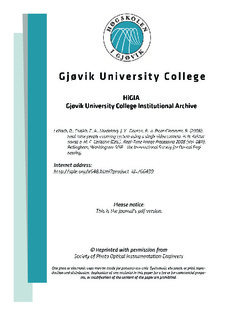| dc.contributor.author | Lefloch, Damien | |
| dc.contributor.author | Cheikh, Faouzi Alaya | |
| dc.contributor.author | Hardeberg, Jon Yngve | |
| dc.contributor.author | Gouton, Pierre | |
| dc.contributor.author | Picot-Clemente, Romain | |
| dc.date.accessioned | 2011-05-04T09:31:53Z | |
| dc.date.available | 2011-05-04T09:31:53Z | |
| dc.date.issued | 2008 | |
| dc.identifier.citation | Lefloch, D., Cheikh, F. A., Hardeberg, J. Y., Gouton, P., & Picot-Clemente, R. (2008). Real-time people counting system using a single video camera. In N. Kehtarnavaz & M. F. Carlsohn (Eds.), Real-Time Image Processing 2008 (Vol. 6811). Bellingham, Washington: SPIE - the International Society for Optical Engineering. | en_US |
| dc.identifier.isbn | 9780819469830 | |
| dc.identifier.issn | 0277-786X | |
| dc.identifier.uri | http://hdl.handle.net/11250/142506 | |
| dc.description | This is the copy of journal's version originally published in Proc. SPIE 6811. Reprinted with permission of SPIE: http://spie.org/x10.xml?WT.svl=tn7 | en_US |
| dc.description.abstract | There is growing interest in video-based solutions for people monitoring and counting in business and security applications. Compared to classic sensor-based solutions the video-based ones allow for more versatile functionalities, improved performance with lower costs. In this paper, we propose a real-time system for people counting based on single low-end non-calibrated video camera. The two main challenges addressed in this paper are: robust estimation of the scene background and the number of real persons in merge-split scenarios. The latter is likely to occur whenever multiple persons move closely, e.g. in shopping centers. Several persons may be considered to be a single person by automatic segmentation algorithms, due to occlusions or shadows, leading to under-counting. Therefore, to account for noises, illumination and static objects changes, a background substraction is performed using an adaptive background model (updated over time based on motion information) and automatic thresholding. Furthermore, post-processing of the segmentation results is performed, in the HSV color space, to remove shadows. Moving objects are tracked using an adaptive Kalman filter, allowing a robust estimation of the objects future positions even under heavy occlusion. The system is implemented in Matlab, and gives encouraging results even at high frame rates. Experimental results obtained based on the PETS2006 datasets are presented at the end of the paper. | en_US |
| dc.language.iso | eng | en_US |
| dc.publisher | Society of Photo Optical Instrumentation Engineers (SPIE) | en_US |
| dc.relation.ispartofseries | Proceedings of SPIE;6811 | |
| dc.title | Real-time people counting system using a single video camera | en_US |
| dc.type | Journal article | en_US |
| dc.type | Peer reviewed | en_US |
| dc.subject.nsi | VDP::Mathematics and natural science: 400::Information and communication science: 420::Simulation, visualization, signal processing, image processing: 429 | en_US |
| dc.source.pagenumber | 12 s. | en_US |
| dc.identifier.doi | http://dx.doi.org/10.1117/12.766499 | |
